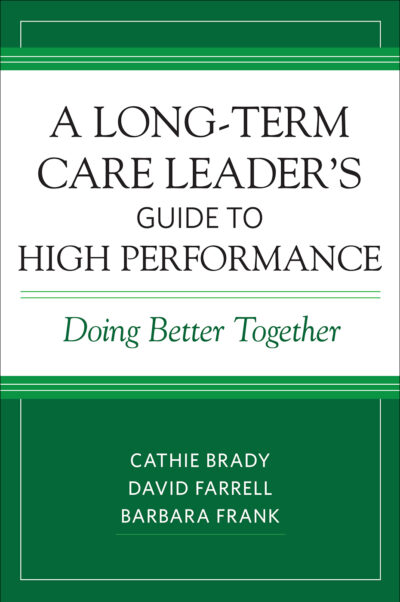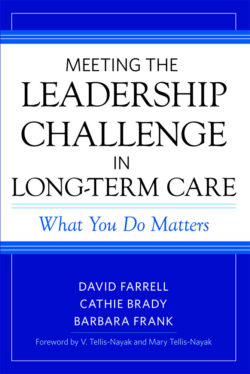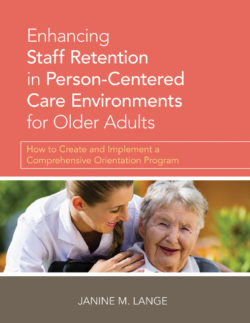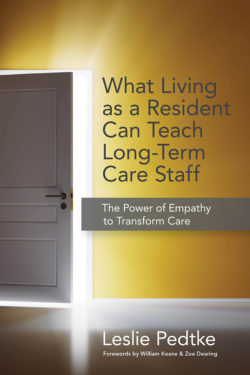Product Description
From the authors of the award-winning Meeting the Leadership Challenge in Long-Term Care, this book provides a blueprint for success in today’s performance-based healthcare system. It presents a tested approach to delivering optimal care to each resident using a proven, coordinated bundle of key practices that include:
- Leadership that brings out the best in staff
- A communication infrastructure to support teamwork throughout an organization
- A high-involvement performance improvement process that delivers quality person-centered care and prevents avoidable declines
This practical resource takes long-term care leaders through the critical steps to achieve staff stability, strengthen coordination of care, and maintain the highest practicable well-being for each resident. It demonstrates how engaging staff in continuous quality improvement produces consistently high-quality care.
Whether care communities are excelling or struggling, leaders can benefit from these performance-improving practices. Filled with candid, impactful personal accounts about implementing quality improvement in nursing homes, A Long-Term Care Leader’s Guide reveals precisely how leaders and their staff can do better, together.
Accompanying downloadable, how-to guides include:
- Three Steps to Transforming the Medication Pass: Individualizing Care and Managing Workflow
- Rethinking the Use of Position-Change Alarms
- Eliminating Off-Label Use of Antipsychotics: A 10-Step Guide for Nursing Homes
- MUSIC & MEMORY℠: Implementation Steps to Maximize Benefits: A Nursing Home Leader’s Guide
- Communication Infrastructure Self-Assessment


 Cathie Brady, M.S., has more than thirty years’ experience providing services and advocating for the elderly in a variety of settings, including serving as Executive Director of the Department of Aging Services for the city of Bristol, Connecticut, and for 10 years as the Regional LTC Ombudsman for Eastern Connecticut. Cathie has an M.S. in Organizational Management from Eastern Connecticut State University. She is co-founder (with her co-author Barbara Frank) of B&F Consulting, where she co-produced a Webcast for the Center for Medicare and Medicaid Services on “The How of Change: ‘What a difference management makes!’” Cathie directed the Connecticut Career Ladder and Culture Change Initiative. For 3 years, she worked with the New Orleans Nursing Home Staffing Project, which helped nursing homes recover from the aftermath of Hurricane Katrina. She co-produced a film with Louisiana Public Broadcasting called The Big Uneasy: Katrina’s Unsung Heroes. Cathie is a frequent speaker at state and national conferences and specializes in leadership development at all levels of an organization to assist nursing homes interested in being better places to live and work.
Cathie Brady, M.S., has more than thirty years’ experience providing services and advocating for the elderly in a variety of settings, including serving as Executive Director of the Department of Aging Services for the city of Bristol, Connecticut, and for 10 years as the Regional LTC Ombudsman for Eastern Connecticut. Cathie has an M.S. in Organizational Management from Eastern Connecticut State University. She is co-founder (with her co-author Barbara Frank) of B&F Consulting, where she co-produced a Webcast for the Center for Medicare and Medicaid Services on “The How of Change: ‘What a difference management makes!’” Cathie directed the Connecticut Career Ladder and Culture Change Initiative. For 3 years, she worked with the New Orleans Nursing Home Staffing Project, which helped nursing homes recover from the aftermath of Hurricane Katrina. She co-produced a film with Louisiana Public Broadcasting called The Big Uneasy: Katrina’s Unsung Heroes. Cathie is a frequent speaker at state and national conferences and specializes in leadership development at all levels of an organization to assist nursing homes interested in being better places to live and work. David Farrell, M.S.W., L.N.H.A., is a licensed nursing home administrator who has spent over 30 years in the healthcare profession. He started as a certified nursing assistant in order to earn extra money while attending college. That experience inspired him to pursue a Master’s degree in Social Work with a concentration in gerontology and administration from Boston College. Throughout his career in various leadership positions, David has advocated for patient-centered care using quality improvement practices. A nationally recognized leader in the field, he has traveled the country to deliver inspiring presentations to health care executives at conferences and training events. Currently, David is the Vice President of Subacute Services at Telecare Corporation located in Alameda, California.
David Farrell, M.S.W., L.N.H.A., is a licensed nursing home administrator who has spent over 30 years in the healthcare profession. He started as a certified nursing assistant in order to earn extra money while attending college. That experience inspired him to pursue a Master’s degree in Social Work with a concentration in gerontology and administration from Boston College. Throughout his career in various leadership positions, David has advocated for patient-centered care using quality improvement practices. A nationally recognized leader in the field, he has traveled the country to deliver inspiring presentations to health care executives at conferences and training events. Currently, David is the Vice President of Subacute Services at Telecare Corporation located in Alameda, California. Barbara Frank, M.P.A., began her career in long-term care by serving 16 years at the National Citizens’ Coalition for Nursing Home Reform in Washington, D.C., where she facilitated the Campaign for Quality, through which providers, consumers, practitioners, and regulators developed consensus on what became the OBRA 1987 legislation that overhauled nursing home regulations to require more individualized care. She has served as state ombudsman for Connecticut. Barbara facilitated the first Pioneer Network gathering in 1997, and in 2005, she facilitated the St. Louis Accord, a national gathering of providers, consumers, regulators, and quality improvement organizations that came together to improve clinical outcomes through culture change. Co-founder (with her colleague, Cathie Brady) of B&F Consulting, she works directly with individual nursing homes to improve their performance measures through workforce retention and culture change. Barbara led a team in the New Orleans Nursing Home Staffing Project, which helped nursing homes recover from the aftermath of Hurricane Katrina. She co-produced a film with Louisiana Public Broadcasting called The Big Uneasy: Katrina’s Unsung Heroes. She co-authored Nursing Homes: Getting Good Care There (1996) and has written extensively on efforts to improve care and outcomes in nursing homes. Barbara has an M.P.A. from the Kennedy School of Government.
Barbara Frank, M.P.A., began her career in long-term care by serving 16 years at the National Citizens’ Coalition for Nursing Home Reform in Washington, D.C., where she facilitated the Campaign for Quality, through which providers, consumers, practitioners, and regulators developed consensus on what became the OBRA 1987 legislation that overhauled nursing home regulations to require more individualized care. She has served as state ombudsman for Connecticut. Barbara facilitated the first Pioneer Network gathering in 1997, and in 2005, she facilitated the St. Louis Accord, a national gathering of providers, consumers, regulators, and quality improvement organizations that came together to improve clinical outcomes through culture change. Co-founder (with her colleague, Cathie Brady) of B&F Consulting, she works directly with individual nursing homes to improve their performance measures through workforce retention and culture change. Barbara led a team in the New Orleans Nursing Home Staffing Project, which helped nursing homes recover from the aftermath of Hurricane Katrina. She co-produced a film with Louisiana Public Broadcasting called The Big Uneasy: Katrina’s Unsung Heroes. She co-authored Nursing Homes: Getting Good Care There (1996) and has written extensively on efforts to improve care and outcomes in nursing homes. Barbara has an M.P.A. from the Kennedy School of Government.



Administrator –
“This insightfully written book will inspire, empower, and teach leaders in long-term care the skills needed to build relationship-rich communities.”
—Kelly Papa, MSN, RN
Corporate Director of Learning, Masonicare
Author of Effective Nurse Leadership: Transforming Long Term Care
Administrator –
“This text is essential reading for all current and future leaders in long-term care. The authors are outstanding in this field, and provide valuable insight. The lessons learned from the text will undoubtedly improve resident care.”
—Nicholas G. Castle, Ph.D.
Professor, Department of Health Policy & Management
Graduate School of Public Health
University of Pittsburgh
Administrator –
“The hardest thing to do in healthcare is to quantify how great healthcare centers achieve their greatness. Brady, Farrell, and Frank do an excellent job of breaking down these components chapter by chapter. A really good book for anyone who wants the ‘secret sauce’ that makes great nursing centers tick.”
—J. Mark Traylor
President & CEO
Traylor-Porter Healthcare
Administrator –
“Exceptionally informed and informative, impressively thoughtful and thought-provoking, remarkably well written, accessibly organized and presented, “A Long-Term Care Leader’s Guide to High Performance” will prove to be of particular and practical interest to anyone with managerial responsibilities in today’s contemporary health care systems and facilities.”
—Margaret Lane, Midwest Book Review